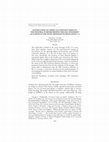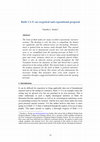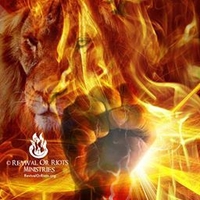Papers by Timothy L Decker
Old Testament Essays, 2019
By using the narrative device of contrastive characterization, the author of Ruth demonstrates th... more By using the narrative device of contrastive characterization, the author of Ruth demonstrates three return-from-exile scenarios that act as a model for the audience. Orpah served as Ruth's foil and represents a return to the pagan culture. Naomi and Ruth project a role reversal. While Naomi returns more like a pagan than a Jewess, Ruth has demonstrated covenant fidelity and illustrated loyalty to YHWH and Israel. She is thus a model for how Jews ought to return from exile to exodus.

Scholars both recently and in the past have sought to bring out the theme of covenant or of a cov... more Scholars both recently and in the past have sought to bring out the theme of covenant or of a covenantal prophetic lawsuit in the book of Revelation and the seven messages specifically. Many of these studies rely on a comparison between common covenantal structures of the ancient Near East and Revelation. What these investigations overlook thus far is how the Old Testament allusions used in the seven messages of Revelation contribute to the covenantal nature of Revelation. Particularly, these allusions are thematically reminiscent of covenantal stipulations, curses, and blessings, as found in places such as the summary of Israel's covenant in Deuteronomy 27-30 (esp. 30:15-20). This article seeks to closely examine the Old Testament allusions in the seventh message to Laodicea (Rev 3:14-22) to demonstrate the covenantal thrust of these allusions and to trace this allusory theme to its theological function and intratextual fulfilment in Revelation 19-22.
The multivalent symbols in the seven messages of Rev 2–3 come from three primary sources: (1) the... more The multivalent symbols in the seven messages of Rev 2–3 come from three primary sources: (1) the socio-historical setting of Asia Minor, (2) the opening chapter of Revelation, and (3) Old Testament allusions. It is the last of these that is of interest in this essay. Specifically, the character of these allusions displays a covenantal quality akin to the Israelite pact initiated at Mt. Sinai. While many have sought to demonstrate the covenantal background of the seven messages through shared structure, none has considered the nature of the Old Testament allusions themselves, as well as the paraenetic function they have for the recipients of the message. This article seeks to demonstrate that the Old Testament allusions in Rev 2–3 convey a covenantal character for the pastoral purpose of encouraging the churches to remain faithful to Jesus, their covenant suzerain/king.
The Journal of the South African Theological Seminary, 2010
... Geisler 1977: 101-102). ... Junius refers it to the times of Deborah and Barak; and others, o... more ... Geisler 1977: 101-102). ... Junius refers it to the times of Deborah and Barak; and others, on account of the famine, think it began in the times the Midianites oppressed Israel, and carried off the fruits of the earth, which caused it, when Gideon was raised up to be their judge; Alting ...

Neotestamentica, 2014
Scholars both recently and in the past have sought to bring out the theme of covenant or of a cov... more Scholars both recently and in the past have sought to bring out the theme of covenant or of a covenantal prophetic lawsuit in the book of Revelation and the seven messages specifically. Many of these studies rely on a comparison between common covenantal structures of the ancient Near East and Revelation. What these investigations overlook thus far is how the Old Testament allusions used in the seven messages of Revelation contribute to the covenantal nature of Revelation. Particularly, these allusions are thematically reminiscent of covenantal stipulations, curses, and blessings, as found in places such as the summary of Israel's covenant in Deuteronomy 27-30 (esp. 30:15-20). This article seeks to closely examine the Old Testament allusions in the seventh message to Laodicea (Rev 3:14-22) to demonstrate the covenantal thrust of these allusions and to trace this allusory theme to its theological function and intratextual fulfilment in Revelation 19-22.
Old Testament Essays, 2019
By using the narrative device of contrastive characterization, the author of Ruth demonstrates th... more By using the narrative device of contrastive characterization, the author of Ruth demonstrates three return-from-exile scenarios that act as a model for the audience. Orpah served as Ruth’s foil and represents a return to the pagan culture. Naomi and Ruth project a role reversal. While Naomi returns more like a pagan than a Jewess, Ruth has demonstrated covenant fidelity and illustrated loyalty to YHWH and Israel. She is thus a model for how Jews ought to return from exile to exodus.
Puritan Reformed Journal, 2019
The point at which preaching Psalm 2 expositionally occurs is when the main point of the sermon a... more The point at which preaching Psalm 2 expositionally occurs is when the main point of the sermon accords with the main thrust of the text. As the structure of Psalm 2 indicates, the appointing of the Davidic King as God’s Son in verses 6–7 is the summit of a volcano. The higher up the sides we climb, either verses 1–5 or 8–12, the hotter we get. Even-tually, the surging lava of the kingship of Christ forces us to either flee in rebellion or seek refuge in God’s King-Son.

Journal of IRBS Theological Seminary, 2018
In order to exegetically defend the doctrine of the Lord’s Day/Christian Sabbath, the Puritans wo... more In order to exegetically defend the doctrine of the Lord’s Day/Christian Sabbath, the Puritans would often militate against those that appealed to Col 2:16 for an abrogation of the Sabbath by arguing the terminology in the passage of “feasts, new moons, and sabbaths” either had to do with special Sabbath holidays specifically (such as Lev 23:33–36) or Jewish ceremonies and festivals given under the old covenant in general. Appealing to the OT to support their interpretation, one of the assumptions they often made in their argument was that such nomenclature was standard terminology for Jewish ceremonial worship. For some, this argument needs further substantiation in order to maintain the rigid Sabbatarian views of the Puritans. A few, especially in the Seventh-Day Adventist denomination, have utilized extra-biblical or non-biblical literature to bolster the claim that Col 2:16 is indeed not referring to the passing away of the weekly Sabbath observance. However, their efforts were narrow in its evaluation and less expansive in its survey of material to persuasively demonstrate the stock language of ceremonial worship that Paul utilized in this passage. Therefore, the goal of this article is not to give exegetical proof for the Puritan and Sabbatarian interpretation of Col 2:16. Rather, an examination is undertaken to a wider range of Second Temple, Historical, Rabbinical, and Early Christian literature that use some form of the lingo of “sabbaths” with “new moons” and/or “feasts.” A special emphasis on the function of the plural “sabbaths” (which is the rendering in Col 2:16, though often not portrayed that way in many modern translations) especially in the context of a grouping with “feasts” and/or “new moons” will help demonstrate the consistent use of this standard verbiage to refer to ceremonial, ritual worship under the old covenant.

Andrews University Seminary Studies, 2017
The multivalent symbols in the seven messages of Rev 2-3 come from three primary sources: (1) the... more The multivalent symbols in the seven messages of Rev 2-3 come from three primary sources: (1) the socio-historical setting of Asia Minor, (2) the opening chapter of Revelation, and (3) Old Testament allusions. It is the last of these that is of interest in this essay. Specifically, the character of these allusions displays a covenantal quality akin to the Israelite pact initiated at Mt. Sinai. While many have sought to demonstrate the covenantal background of the seven messages through shared structure, none has considered the nature of the Old Testament allusions themselves, as well as the paraenetic function they have for the recipients of the message. This article seeks to demonstrate that the Old Testament allusions in Rev 2-3 convey a covenantal character for the pastoral purpose of encouraging the churches to remain faithful to Jesus, their covenant suzerain/king.

Conspectus, 2010
The book of Ruth makes for many excellent expositional, narrative
sermons. The theology is rich, ... more The book of Ruth makes for many excellent expositional, narrative
sermons. The theology is rich, the story is compelling, the themes
are significant, and the cultural mores are fascinating. Therefore,
much is gained from an intense study through Ruth. This journal
article sets out to demonstrate exactly how rich and detailed this
story is, as exemplified from the opening pericope of Ruth 1:1-5.
Part of the exegetical task is to uncover many great morphological
puns and ironic elements which are so eloquently placed within.
There is also an inherent tension growing throughout the Old
Testament between the dynasties of Saul and David that is partly
played out in the setting of Ruth. This tension helps to express one of
the primary purposes for the book of Ruth—a political advertisement
for the house of David. This article will also demonstrate the
necessary bridge that preachers must cross from exegesis to
exposition through a suggested homiletical outline from the opening
pericope.
Teaching Documents by Timothy L Decker
Sermon on the Mount:
A diplomatic critical edition of Scrivener's TR with a critical apparatus o... more Sermon on the Mount:
A diplomatic critical edition of Scrivener's TR with a critical apparatus of over 20 different editions among the TR tradition.








Uploads
Papers by Timothy L Decker
sermons. The theology is rich, the story is compelling, the themes
are significant, and the cultural mores are fascinating. Therefore,
much is gained from an intense study through Ruth. This journal
article sets out to demonstrate exactly how rich and detailed this
story is, as exemplified from the opening pericope of Ruth 1:1-5.
Part of the exegetical task is to uncover many great morphological
puns and ironic elements which are so eloquently placed within.
There is also an inherent tension growing throughout the Old
Testament between the dynasties of Saul and David that is partly
played out in the setting of Ruth. This tension helps to express one of
the primary purposes for the book of Ruth—a political advertisement
for the house of David. This article will also demonstrate the
necessary bridge that preachers must cross from exegesis to
exposition through a suggested homiletical outline from the opening
pericope.
Teaching Documents by Timothy L Decker
A diplomatic critical edition of Scrivener's TR with a critical apparatus of over 20 different editions among the TR tradition.
sermons. The theology is rich, the story is compelling, the themes
are significant, and the cultural mores are fascinating. Therefore,
much is gained from an intense study through Ruth. This journal
article sets out to demonstrate exactly how rich and detailed this
story is, as exemplified from the opening pericope of Ruth 1:1-5.
Part of the exegetical task is to uncover many great morphological
puns and ironic elements which are so eloquently placed within.
There is also an inherent tension growing throughout the Old
Testament between the dynasties of Saul and David that is partly
played out in the setting of Ruth. This tension helps to express one of
the primary purposes for the book of Ruth—a political advertisement
for the house of David. This article will also demonstrate the
necessary bridge that preachers must cross from exegesis to
exposition through a suggested homiletical outline from the opening
pericope.
A diplomatic critical edition of Scrivener's TR with a critical apparatus of over 20 different editions among the TR tradition.